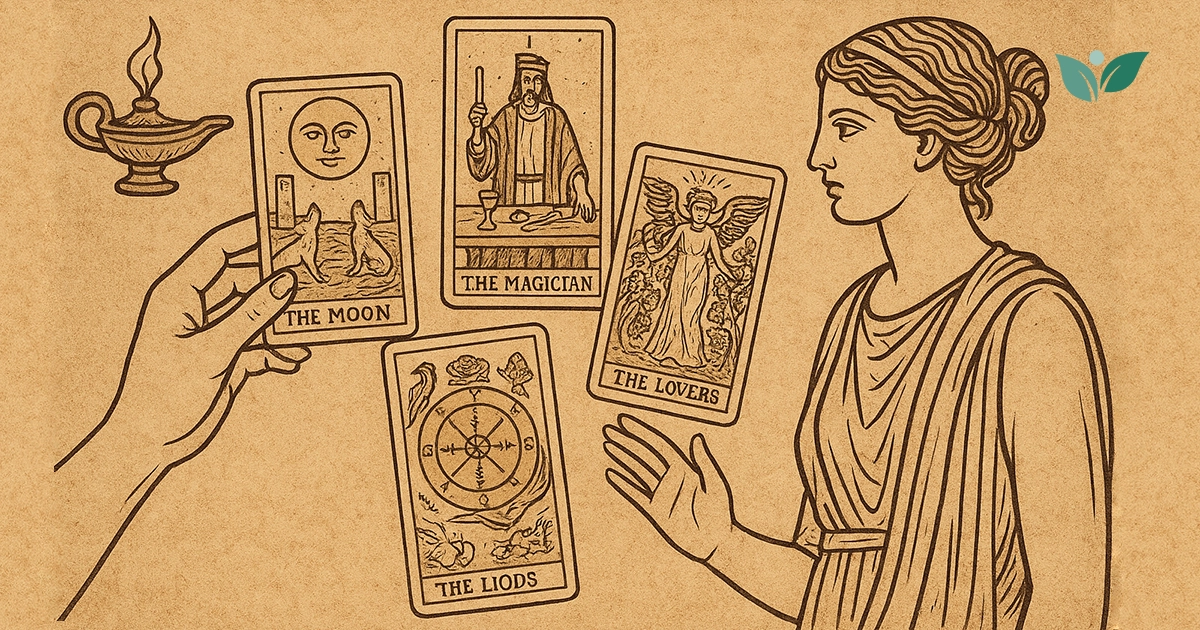Tarot has fascinated humanity for centuries, weaving its way into spiritual practices, psychological reflection, and even pop culture. Whether seen in movies as a mysterious fortune-telling tool or on Instagram as part of a modern wellness routine, tarot continues to captivate beginners and experienced readers alike.
For many newcomers, though, tarot feels intimidating. With 78 cards, countless spreads, upright and reversed meanings, and the challenge of interpreting symbols, it’s easy to think tarot is too complex to master. Some people even believe you must be psychic to read the cards.
But here’s the truth: anyone can learn tarot. You don’t need mystical powers—you only need patience, practice, and an open mind. Tarot is a symbolic language, and like any language, the more you use it, the more fluent you become.
This guide is designed to be your complete roadmap into the world of tarot. From choosing your first deck and understanding the Major and Minor Arcana to learning simple spreads and avoiding beginner mistakes, you’ll gain everything you need to confidently start your tarot journey.
By the end, you’ll not only understand the basics but also have practical tools to read for yourself and others. Let’s begin.
Table of Contents
- What is Tarot?
- Understanding the Tarot Deck
- Major Arcana
- Minor Arcana
- Suits & Court Cards
- Choosing Your First Tarot Deck
- Cleansing & Connecting With Your Deck
- How to Do a Tarot Reading
- Tarot Spreads for Beginners
- How to Interpret Tarot Cards
- Common Beginner Mistakes
- Practicing Tarot Daily
- Tarot Journaling
- Ethics of Tarot Reading
- Advanced Tips for Growth
- Tarot vs. Oracle Cards
- FAQs
- Conclusion
What is Tarot?
Tarot is a deck of 78 illustrated cards used for divination, self-reflection, and guidance. While it’s often portrayed as a tool for fortune-telling, tarot is better understood as a mirror for the subconscious mind—a way to explore your intuition and life path.
A Brief History of Tarot
Tarot originated in the 15th century in Europe, not as a mystical tool but as a playing card game called tarocchi. The mystical associations only came later in the 18th century when occult scholars began linking tarot to astrology, numerology, and Kabbalah.
Over the centuries, tarot transformed into a respected divination system. Today, it’s used by psychologists for self-reflection, spiritual seekers for guidance, and hobbyists for personal growth.
Myths and Misconceptions
- Myth: Tarot predicts the future with certainty.
- Truth: Tarot highlights possible paths; your choices shape the outcome.
- Myth: You must be psychic to read tarot.
- Truth: Tarot is a learned skill, developed through practice.
- Myth: Tarot is dangerous or evil.
- Truth: Tarot is a neutral tool. The reader’s intent defines its use.
Why Learn Tarot?
- Encourages self-awareness
- Offers problem-solving insights
- Strengthens intuition
- Inspires creativity
Tarot isn’t about predicting a fixed fate. It’s about understanding yourself and your life’s journey.
Understanding the Tarot Deck
A tarot deck contains 78 cards, divided into:
- Major Arcana (22 cards): Big life themes, spiritual lessons.
- Minor Arcana (56 cards): Day-to-day events, emotions, and actions.
Major Arcana
The Major Arcana includes well-known cards like The Fool, The Magician, The Lovers, Death, and The World. These cards represent powerful archetypes that symbolize major transitions and turning points.
- The Fool (0): New beginnings, innocence, risk-taking.
- Death (XIII): Transformation, endings leading to new beginnings.
- The World (XXI): Completion, success, integration.
When a Major Arcana appears in a reading, it signals a pivotal life lesson.
Minor Arcana
The Minor Arcana is made up of four suits:
- Wands: Inspiration, action, creativity.
- Cups: Emotions, relationships, intuition.
- Swords: Intellect, conflict, truth.
- Pentacles: Material life, work, finances.
Each suit contains ten numbered cards and four Court Cards (Page, Knight, Queen, King). These reflect everyday situations.
Upright vs. Reversed Cards
- Upright: Traditional meaning (e.g., Ace of Cups = new emotional beginning).
- Reversed: Blocked or opposite energy (e.g., Ace of Cups reversed = emotional blockage).
Choosing Your First Tarot Deck
Your first tarot deck should resonate with you visually and energetically.
- The Rider-Waite-Smith (RWS): The most popular beginner deck with clear imagery.
- Modern Decks: Choose designs (minimalist, artistic, cultural) that inspire you.
- Tips:
- Don’t overthink—choose the deck that “calls” to you.
- Start with one deck to avoid confusion.
Cleansing & Connecting With Your Deck
Once you have your deck, it’s important to connect with it.
Cleansing Rituals
- Smoke cleansing with sage or incense
- Crystal cleansing (amethyst, clear quartz)
- Moonlight cleansing (leave under the full moon)
Bonding Practices
- Shuffle the cards daily
- Do a “card of the day” pull
- Meditate on each card’s imagery
How to Do a Tarot Reading
- Prepare your space – quiet, distraction-free.
- Shuffle the deck while focusing on your question.
- Cut the deck and lay out the cards.
- Interpret using intuition + card meanings.
- Reflect and write down your insights.
Tarot Spreads for Beginners
- One-Card Draw: Simple daily guidance.
- Three-Card Spread: Past, present, future.
- Five-Card Spread: Situation, challenges, advice, outcome, hidden influences.
- Celtic Cross: A detailed 10-card spread (advanced beginners).
How to Interpret Tarot Cards
- Use symbols, imagery, and intuition.
- Pay attention to upright vs. reversed meanings.
- Read cards as part of a story (how they interact).
- Keep a tarot journal to track interpretations.
Common Beginner Mistakes
- Relying only on guidebooks
- Fearing “negative” cards (Death, Devil, Tower)
- Asking vague or yes/no questions
- Reading for others too soon without practice
Practicing Tarot Daily
- Pull one card every morning.
- Reflect on how it applies during the day.
- Meditate with your deck.
- Join tarot communities for practice.
Tarot Journaling
Keep a tarot diary:
- Write the date, question, spread, and cards.
- Record interpretations + later reflections.
- Helps you see patterns and track growth.
Ethics of Tarot Reading
- Respect free will—don’t predict death or tragedy.
- Be honest about your skill level.
- Keep readings confidential.
- Use tarot for guidance, not control.
Advanced Tips for Growth
- Study deeper symbolism (astrology, numerology).
- Explore shadow work with tarot.
- Experiment with multiple decks.
- Try reading intuitively without structured spreads.
Tarot vs. Oracle Cards
- Tarot: 78 structured cards, consistent archetypes.
- Oracle: Flexible number of cards, free themes.
- For beginners: Tarot provides structure, Oracle offers freedom.
- Many readers combine both.
Frequently Asked Questions
- Do you need to be psychic to read tarot? No, anyone can learn with practice.
- Can tarot predict the future? Tarot shows possibilities, not fixed outcomes.
- How long does it take to learn? With daily practice, you’ll gain confidence within months.
- Is tarot against religion? Tarot is a tool—it depends on your beliefs.
- How many decks should I own? Start with one. Expand as you grow.
Conclusion
Tarot is not just about predicting the future—it’s about empowerment, clarity, and self-discovery. As a beginner, remember that every expert reader once started where you are now.
Start simple. Pull one card daily. Keep a journal. Trust your intuition. Over time, you’ll notice patterns, insights, and growth in your readings.
Tarot is a journey, not a destination. The more you practice, the deeper your connection with the cards becomes.
👉 Your journey begins with the first shuffle. Pick up your deck, ask a question, and draw your first card today.


